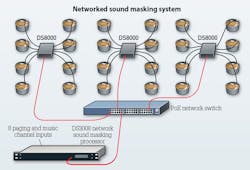From the June 2015 Issue of Cabling Installation & Maintenance Magazine
Used in open-office space and other environments, sound masking systems can use communications cabling as an infrastructure.
Sound masking can be added to the growing list of building systems that can use communications cabling as a wired infrastructure. They can be deployed for a number of reasons, primarily including worker comfort and privacy as well as confidential (e.g., doctor-patient) communication. And sound masking systems need not be networked, although they can be.
Cambridge Sound Management (www.cambridgesound.com) is one provider of sound management systems. In a recent Web-delivered seminar hosted by Cabling Installation & Maintenance, the company's field sales engineer, Jeremy Krug, explained the need, function, and effectiveness of these systems in office environments. Focusing his presentation on acoustic privacy, Krug simplified the concept by dividing it into three "A-B-C" parts: absorb, block, and cover. Sound masking systems are an option for "C"-cover.
Krug detailed that absorption is "simply the process of adding acoustically absorptive materials to a space. Common examples include acoustic ceiling tiles, acoustic wall panels, and carpeting. Blocking sound is the use of solid barriers to block the direct sound from one person to another. Typical examples are cubicle partitioning, walls, windows, doors, or any material that has an associated mass that can act as a barrier to sound.
"Cover," Krug emphasized, "aims to describe the background noise level in an environment. This can be a function of HVAC noise, vehicular traffic, water noise, or anything that is contributing to the background noise level. One of the tools that we use to control background sound is sound masking."
Lack of privacy
He summarized the state of the modern open office as one that easily can neglect worker privacy. "Cubicle partition heights have come down significantly," he noted. "Gone are the days of using 60-, 65-, or 70-plus-inch partitions. These days, 48- and 54-inch partitions are the norm. When the open office environment was created years ago, it wasn't uncommon to see 10-by-10-foot cubicles. However, today the typical size of cubicles is more like 8-by-6 or 6-by-6. Benching is also a popular office configuration that is gaining significant traction because it allows many people to fit into a small space." He added that absorptive elements like carpet, acoustical tiles and cubicle walls have become less common over recent years.
These physical setups-for which there are multiple drivers including facilitating collaboration and allowing maximum natural light into a space-nonetheless contribute to the current reality of a lack of privacy in the workplace. That lack of privacy is not just socially awkward for many employees; it also hurts worker productivity in many cases.
In a recent issue of its publication 360, office-furniture provider Steelcase (360.steelcase.com) produced a feature titled "The Privacy Crisis-Taking a Toll on Employee Engagement." Citing research conducted by Gallup, Steelcase noted, "[O]nly 11 percent of workers around the world are engaged and inspired at work, and 63 percent are disengaged-unmotivated and unlikely to invest effort in organizational goals or outcomes … Moreover, a recent Steelcase study of the workplace … of more than 10,500 workers in Europe, North America and Asia confirms that insufficient privacy in the workplace is an issue throughout the world. The survey results show that being able to concentrate, work in teams without being interrupted or choose where to work based on task are frequently unmet needs.
"Yet the 11 percent of workers who had more privacy and were more satisfied with their workplace overall were also the most engaged. Conversely, employees highly dissatisfied with their work environment were the least engaged. The study confirms observations made by Steelcase researchers: The workplace has a very real impact on employee engagement."
In medical buildings, the need for privacy is mandated by law. HIPAA-the Health Insurance Portability and Accountability Act-is the most-frequently cited piece of legislation that underscores the need for privacy in these environments. Cambridge Sound Management's Krug noted, "Introduced in 1996, HIPAA attempts to make healthcare designers aware of how design practices affect patient privacy. This includes many forms of privacy, including acoustic. Unfortunately, HIPAA does not instruct designers on specific design practices, but rather states that designers 'should take reasonable safeguards to protect the privacy of protected health information.'"
A wired infrastructure
This combination of the modern open-office workplace and current healthcare-related requirements have prompted some building owners and managers to incorporate sound masking systems. Sound masking, as Krug pointed out, is the addition of sound into an environment. "Many forms of sound or noise can be used for masking. With respect to modern architecture and building standards, sound masking is employed electronically with loudspeakers connected to amplifiers." He added that properly designing a sound masking system is important to its effectiveness, because these systems perform best when the sound produced is as uniform as possible in all locations. "Any hot spots, dead spots, or other changes to the noise only serves to increase the likelihood of the occupants noticing it," he said.
Despite sound masking systems' fairly recent arrival in the structured cabling sphere, the concept of providing electronically produced sound to a space has existed for decades and the technologies for doing so have evolved. As a result, different sound masking systems have distinct characteristics and/or approaches to achieving their goals.
Cambridge's Qt (Quiet technology) systems employ what it calls a direct-field approach. The company explains, "In a standard office environment, miniature emitters are installed in ceiling tiles and deliver a pleasant, non-distracting, air-conditioning-like sound into the targeted space. If your ceiling isn't 'standard,' emitters can be mounted to exposed beams or even embedded in furniture or other fixtures." Category cabling connects the emitters to control modules in a central room or closet.
Dynasound (www.soundmasking.com) is another provider of sound masking systems, including centralized, distributed, and networked architectures. The company says that when choosing a system, recognize that acoustical requirements vary from office to office. "One of the first considerations, when designing a sound masking system, is to determine the most advantageous speaker type and placement. The system capabilities must also be determined. For example, the system may be a basic sound masking system or a system with many zones of sound masking, paging, and music channels."
As for the different architectures, Dynasound explains, "Centralized sound masking systems have been a professional approach to commercial sound masking since the mid 1970s. Even with the development of networked sound masking systems, centralized systems are often still a good choice. Centralized systems provide manual per-speaker volume control, hard-wired zones, and cannot be reconfigured via software … Speakers are daisy chained together into hard-wired zones using standard two-conductor audio cable. All speakers in a given zone receive the same audio signal. Complex multi-channel sound masking, paging, and music systems can require large equipment racks containing generators, mixers, equalizers and amplifiers."
Distributed systems, the company further explains, "are a cost-effective approach to small systems, consisting of perhaps a single speaker or just a few speakers. No centralized or networked 'front-end' equipment is needed." Describing the use of its DS1082 sound masker, Dynasound continued, "Each sound masker is a self-contained system. Each has individually adjustable volume and low-pass filter controls. Up to 10 sound-maskers can be powered from one transformer."
As for networked sound masking, the company comments, "Networked audio, with addressable speakers, has become the preferred approach to sound masking, paging, and music distribution. While offering the utmost in flexibility and control, networked systems consist of a few easy-to-specify components, use standard network hardware, are CobraNet ready, and allow control of every speaker individually."
Specifically detailing the configuration of its networked system, Dynasound says, "The DS3008 processor connects external paging and music signals into the digital network. Each DS8000 is an eight-channel receiver and amplifier containing four sound masking generators and full DSP processing capability. Speaker connections are made with standard two-conductor audio cable. Other connections use standard network Category 5 cable."
Dynasound's networked sound masking system is Power over Ethernet-enabled, using industry standard PoE switches, the company says. "Our systems do not require managed switches. We recommend the Netgear FS728TP for most installations."
When sound masking is recognized as an important element of business operations, and becomes part of an organization's functional systems, opportunities arise to design and install these systems and their wired infrastructure. ::
Patrick McLaughlin is our chief editor.

